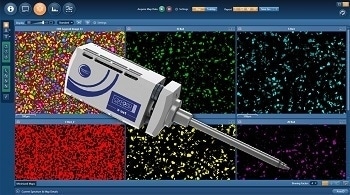Oxford Instruments, a leader in microanalysis systems, has launched the AZtecOneXT system, an ideal solution for those who want to perform a complex task like EDS as quickly and as easily as possible. The AZtecOneXT system is an addition to the class leading AZtec software platform and comprises the new AZtecOne software platform for EDS analysis and an x-act silicon drift detector.
 AZtecOneXT is a new standard of simplicity for EDS analysis.
AZtecOneXT is a new standard of simplicity for EDS analysis.
The AZtecOne software has been designed to help users have all the necessary tools at hand to complete an analysis task quickly and with ease. The proven technology and reliability of Oxford Instruments software algorithms and hardware mean that not only are results easily obtained, but they are accurate and dependable.
A streamlined interface minimises the number of steps to get a result, new users can be productive in a matter of minutes, and there’s no need for the infrequent user to be retrained every time they need to perform an analysis. Results can be easily exchanged between AZtecOne and the more powerful AZtecEnergy.
The AZtecOneXT system will allow a new range of users to benefit from the accuracy and power of Oxford Instruments EDS analysis technology. Even inexperienced users can get the ‘right results first time’ just seconds after launching the software.
AZtec Product Manager, Anthony Hyde
About Oxford Instruments plc
Oxford Instruments designs, supplies and supports high-technology tools and systems with a focus on research and industrial applications. Innovation has been the driving force behind Oxford Instruments' growth and success for over 50 years, and its strategy is to effect the successful commercialisation of these ideas by bringing them to market in a timely and customer-focused fashion.
The first technology business to be spun out from Oxford University, Oxford Instruments is now a global company and is listed on the London Stock Exchange (OXIG). Its objective is to be the leading provider of new generation tools and systems for the research and industrial sectors with a focus on nanotechnology. Its key market sectors include nano-fabrication and nano-materials. The company’s strategy is to expand the business into the life sciences arena, where nanotechnology and biotechnology intersect
This involves the combination of core technologies in areas such as low temperature, high magnetic field and ultra high vacuum environments; Nuclear Magnetic Resonance; X-ray, electron, laser and optical based metrology; atomic force microscopy; optical imaging; advanced growth, deposition and etching.
Oxford Instruments aims to pursue responsible development and deeper understanding of our world through science and technology. Its products, expertise, and ideas address global issues such as energy, environment, security and health.